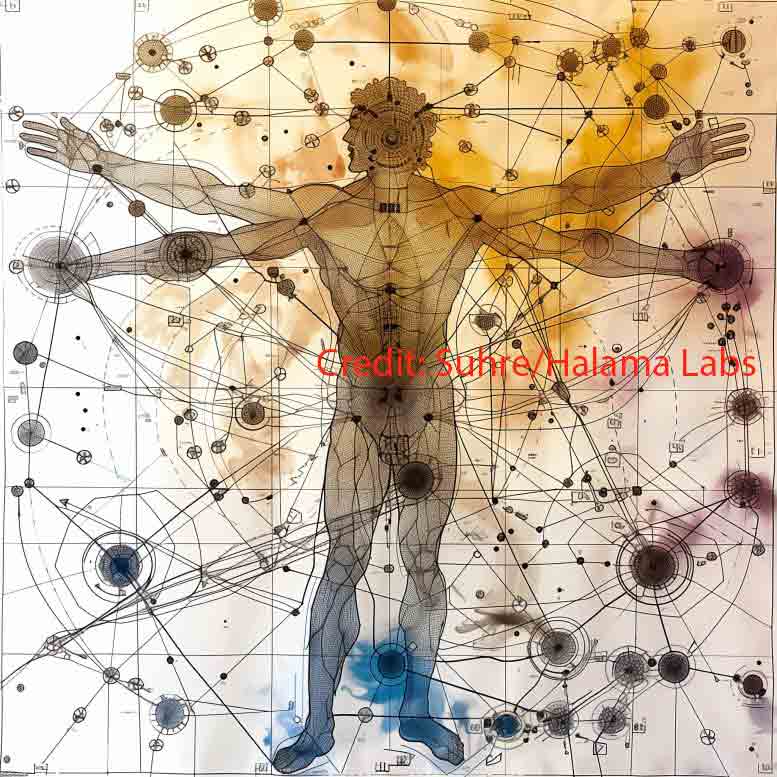12 Years of Research: New Human ‘Molecular Map’ Unveils Body’s Hidden Secrets
Research human molecular map
Scientists have pioneered an interactive molecular map of the human body, named COmics, drawing from extensive multiomics data. This innovative tool empowers researchers to probe molecular processes and traits related to diseases such as diabetes, unlocking vast potential for future scientific breakthroughs.
A team at Weill Cornell Medicine in Qatar (WCM-Q) meticulously crafted a molecular atlas of the human body’s physiological intricacies by examining thousands of molecules found in blood, urine, and saliva from 391 volunteers.
This comprehensive dataset was synthesized into a cutting-edge, interactive web tool called Connecting Omics (COmics), designed to decode the molecular complexities of human biology and reveal traits connected to various medical conditions.
The molecular mechanisms of the human body encompass the myriad chemical reactions and interactions taking place both within and between cells.
These processes govern essential functions like DNA replication, protein formation, energy generation, and intercellular communication, all orchestrated through intricate interactions among proteins, DNA, and RNA. Together, these processes sustain life’s vital functions.
Research human molecular map: Study Overview and Context
The exhaustive research, published on August 19 in Nature Communications, spans 12 years of data collection from the Qatar Metabolomics Study of Diabetes (QMDiab), focusing on a diverse population in Qatar, primarily of Arab, Filipino, and Indian heritage.
“Our ambition was to consolidate over a decade of multiomics insights into a unified molecular model of the human body,” stated senior author Dr. Karsten Suhre, professor of physiology and biophysics and a key figure at the Englander Institute of Precision Medicine.
“This reference tool is freely accessible, offering researchers the means to explore human biology at a molecular level and form hypotheses for experimental validation.”
Data Compilation and Analytical Process
In collaboration with Hamad Medical Corporation, researchers gathered blood, urine, and saliva samples from individuals both with and without diabetes. The samples underwent characterization across 18 high-throughput platforms, yielding an exceptionally rich dataset that included 6,300 individual molecular data points, ranging from genomic (DNA) and transcriptomic (RNA) data to proteins and metabolites like amino acids, sugars, and lipids.
Furthermore, genetic variants, DNA methylation patterns, and gene expression data were also identified for each participant.
This enabled the team to unveil connections between genetic characteristics, specific proteins, metabolic pathways, and diseases. The integration of this vast dataset culminated in an online tool that provides a detailed molecular portrait of the human body.
Research human molecular map: The Power of Multiomics Research
The fusion of genomic, transcriptomic, metabolomic, proteomic, and other ‘omics’ data, collectively termed ‘multiomics,’ has risen to prominence as a vital strategy in biomedical research. It offers profound insights into human biology and disease mechanisms, paving the way for novel therapeutic interventions.
Notably, the study revealed distinct proteins and metabolites that serve as biomarkers for various subtypes of type 2 diabetes, offering new perspectives on the disease’s diverse manifestations.
“Our integrative omics approach presents a comprehensive view of the connections between molecular traits and an individual’s phenotype—observable characteristics like appearance, biochemical functions, and behaviors,” explained lead author Dr. Anna Halama, assistant professor of research in physiology and biophysics.
“The vast data within the COmics web tool provides researchers with access to hundreds of thousands of pathways and associations, opening up unprecedented opportunities for exploration and discovery.”
Reference
“A roadmap to the molecular human linking multiomics with population traits and diabetes subtypes” by Anna Halama et al., published August 19, 2024, in Nature Communications.
DOI: 10.1038/s41467-024-51134-x
Dr. Suhre’s work is supported by the Biomedical Research Program at Weill Cornell Medicine in Qatar, funded by Qatar Foundation, as well as by Qatar National Research Fund (QNRF) grants NPRP11C-0115-180010 and ARG01-0420-23000. Dr. Halama is supported by QNRF grants NPRP12S-0205-190042 and NPRP11S-0122-180359.







